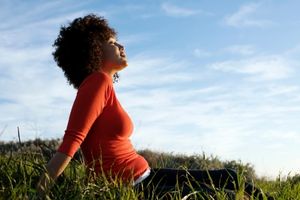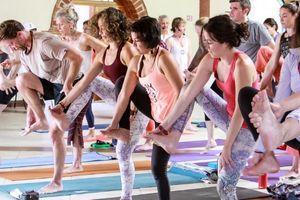3 Ways to Activate Muscle Energy
Categories: Methodology

Activate Muscular Energy through a Mental Map
Anusara Yoga’s 2nd Universal Principle of Alignment (UPA) is Muscular Energy. As a hallmark of Anusara’s methodology, UPA’s help us connect with all parts of ourselves through our appendages (arms and legs) as well as our axial skeleton (trunk / spine). While we apply Muscle Energy throughout our body, often a good place to begin to understand this UPA is through our legs.
Chiefly, we activate Muscle Energy in our legs through 3 different actions.
- Hug muscles to bones.
- Squeeze the legs to the body’s midline.
- Draw from foot to core (focal point in pelvis).
While all (3) actions performed sequentially are essential for optimal flow, let’s cultivate a deeper connection to the 3rd action. Specifically, let’s focus on the draw from foot to core through a series of easy exercises that include visual imagery thereby helping us connect to the concept.
Why Focus on Periphery to Core?
Developing a deeper connection of periphery to core and in this case – foot to core – offers tremendous well being benefits including the following.
- Awakens our ability to draw into our power center
- Creates deep inner stability
- Highly therapeutic
Value of Using Imagery to Help Activate Muscle Energy
Mind / Body researchers recognize our ability to create mental maps of our own body as well as our ability to create new neural pathways leading to positive change.
What is a Mental Map?
A mental map is a point-of-view perception of an area of interaction. In this case, we are discovering how to facilitate a deeper felt-sense knowing of our foot’s connection to our core or center.
In Anusara Yoga, we call this collection of energy coalescing at a center a “focal point.”
Anusara Yoga’s Focal Points
Essentially, in Anusara Yoga’s methodology, our body has 3 primary focal points.
- core of the pelvis
- heart center
- soft upper palate of the mouth
In order to learn more about Anusara Yoga’s philosophy and the power of understanding focal points, please study with a licensed Anusara Teacher near you. In like manner, to help embody the teachings, attend a workshop, retreat, or training with an Anusara teacher.
Use Visual Imagery to Create a New Mental Map
An easy doorway into creating a new mental map – or a new connection of “how to draw from periphery to the focal point of our core” – might involve using imagery when describing an action or a sensation.
In fact, modern researchers are uncovering a solid recognition that imagery exercises – without any overt movement or muscle activation – leads to the activation of the brain’s same areas as actual movement.
Accordingly, significant research on the power of mental imagery involves gait and Parkinson’s Disease combined with mental imagery for rehabilitation.
Hence, building a “mental picture,” whether through teaching anatomy or using a metaphor, may help us better connect with Anusara Yoga’s 2nd Universal Principle of Alignment – Muscular Energy – and specifically “how to” draw from periphery to core.
Sambandha: Connection to your most Sacred Bone and its Relationship to your Heart
Watch this edited excerpt from Samudra Shakti Online with Certified Anusara Teacher, Lisa Long, as she helps you experience embodiment by creating a mental map of anatomical connection to your heart.
Mental Images to Activate Muscle Energy
As an illustration, try these mental images using a few metaphors for increasing your ability to access muscular energy and particularly muscular energy from foot to core.
Learn how to activate muscle energy and embody a “draw in” from periphery to core explicitly using metaphors to evoke visual imagery.
- Supine Leg Slides
First, recline on your back. At the same time, keep one knee bent and foot firmly rooted to the floor while you extend the opposite leg.
Keep your extended leg heel touching the floor. Press down through the heel of the extended leg and spread your toes wide in order to begin feeling muscle energy.
Additionally, breathe.
Now, Imagine your long leg is a fishing pole. You just caught a big fish.
To stabilize your rod, draw isometrically from your heel to your core without moving your leg and keeping your heel rooted on the ground.
Breathe.
To reel your fish in, as you exhale, drag your heel on the floor towards your pelvis. Actually, bend your knee to drag your heel towards your buttocks.
Balance against the imaginary weight. Allow the weight of your “fish on the line” to be held by the power of your center.
Afterwards, repeat visual imagery and actions on your second side. - Wide Leg Tadasana
Stand with your legs in a comfortable wide stance. Breathe.
Then, pressing down into the 4 corners of your feet (big toe ball joint, inner heel, baby toe ball joint, outer heel), simultaneously pull up through the arches of your feet through the inner line of your legs to your pelvis.
Meanwhile, imagine at the arches of your feet, there is a straw. To emphasize the action, imagine you are literally sucking up through the bone marrow into the core of the pelvis.
In particular, it’s even fun to make a “slurp” sound as you imagine an upward drawing energy through your straw. - Seated Pandagusthasana
Sit in a stable chair. Then, bring your sit bones towards the front edge of your chair so you are not relaxing into the chair’s back.
Begin with one knee bent and foot on the floor coupled with your opposite leg extended.
Pressing down into your bent knee foot on the floor, breath in. While you exhale, press down into the back of your long leg heel and also draw it into your core — as if someone is trying to tickle your foot.
As you draw your grounded long leg in – from periphery to core – you may also isometrically drag its grounded heel back towards your chair.
A key point from this point forward is to keep this feeling of “retracting from tickling” with your long, extended leg.
Markedly, keep this feeling before you lift your leg.
Above all, breathe. Finally, waiting for your next exhale, push your bent knee foot into the floor as you lift your extending leg in the air through a deep connection to the core of your pelvis.
Certainly, if any of these exercises require clarification, please work with a licensed Anusara teacher to help you understand and feel better. Moreover, an Anusara teacher may help address your specific needs in the moment.
How to Active Muscle Energy
Continue to explore Anusara Yoga’s 2nd Universal Principle of Alignment – Muscular Energy. Enjoy spending time on your mat with visual imagery. Furthermore, discover how creating a mental map helps you connect with deeper core stability.
As well, as you explore and practice, remember Muscular Energy is just one of Anusara Yoga’s 5 Universal Principles of Alignment.
- Open to Grace / Set the Foundation
- Muscular Energy
- Inner Spiral
- Outer Spiral
- Organic Energy
In summary, these 5 UPA’s work together to help us re-connect with our Optimal Blueprint in addition to the energetic contraction and expansion of our life’s pulsation.
About the Content Creator

Lisa Long, M.A.
Lisa wants to live in a world where Love gives you a permission slip to drop the mask and be who you are. She enjoys practicing near water to remind her to remain in Love’s flow.







